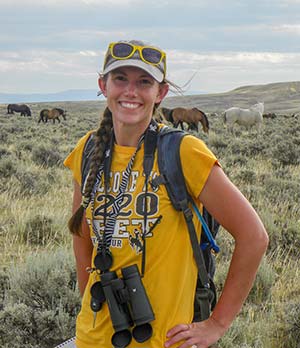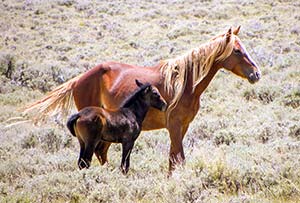
A University of Wyoming rangeland ecology master’s student is examining the gut microbiome in free-roaming horses and how it adapts to different environments and diets, and if certain microbiome communities create a better body condition score.
Free-roaming horses inhabit and thrive in various landscapes, including areas with low availability of forage, and Courtney Buchanan wants to understand the diet of these horses as they adapt to low-quality areas.
Buchanan, who grew up in Massachusetts and graduated with her undergraduate degree in animal science from Utah State University, has always been interested in the wild horse dilemma and took immediate interest in this project.
“Free-roaming horses have come to inhabit a bunch of different environments as managed by the Bureau of Land Management (BLM) throughout the West, and they kind of pose a problem in some areas because their population just grows so quickly,” Buchanan says.
After receiving travel approval, Buchanan spent the summer taking fecal samples from 15 BLM herd management areas across the West. She explains these samples will be sent to a lab to see what bacteria and plant matter are present.
“One of the things we want to look at is if their diet is adjusting to relative availability of herbaceous cover,” Buchanan says. “Horses are generally thought to eat a diet of mostly grass, but there have been some studies in the past showing them eating high amounts of different forbs and sometimes browse.”
Buchanan wants to examine if the horses’ diet has a greater proportion of browse present when there is less herbaceous plant matter available.

“We also want to compare that seasonally,” she says. “So, what’s the difference in the summer versus the winter?”
She also hopes her project will help tell her how the diets and microbiome communities affect the body condition score of these free-roaming horses. Based on her data, Buchanan is seeing a slight trend between areas with higher herbaceous cover and higher body condition scores.
“Which theoretically makes sense,” Buchanan says.
She will travel to these areas this winter to collect samples again and run the same lab tests and data analysis.
“I’m hoping we will get approved for travel this winter,” Buchanan says. “That’s kind of a concern for me.”
Buchanan was accepted into the master’s program at UW after an interview with Jeffrey Beck and Derek Scasta, professors in the Department of Ecosystem Science and Management.
“She’s been a good student who really wants to understand these questions about wild horses in the West,” Beck says.
Buchanan’s project is funded by the Genomes Underlying Toxic Tolerance-Community grant program in conjunction with work at the University of Nevada-Reno, Boise State University and UW.

